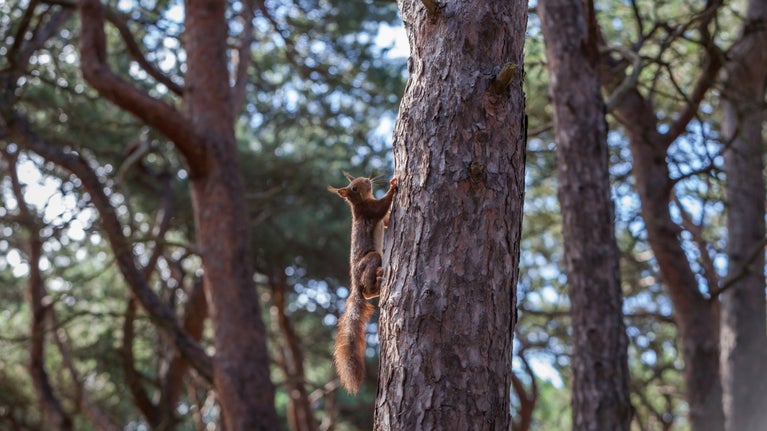
The top spots for seeing red squirrels
Discover the best places in our care across England, Wales and Northern Ireland for spotting red squirrels.

The red squirrel (Sciurus vulgaris) is one of our most popular and well-loved mammals. Find out where they live, the best times to see them and how to spot them.
It’s all about finding the right place and keeping very quiet. They are shy creatures and will run away if they hear you coming.
Red squirrels are most active in spring and autumn, and these are the best seasons to spot them. In spring, squirrels are out and about feeding on emerging foliage and flowers. In autumn, they're busy building up their winter stores and can be seen scuttling about on the woodland floor.
Squirrels will generally be seen during the quieter times of the day, so a good time to see them is first thing or later in the afternoon. Even better, at Brownsea Island in Dorset you can stay overnight on the campsite and go red squirrel spotting after all the other visitors have gone home.

Red squirrels are not always red. They vary in colour and can be brown, greyish or nearly black. They can also have white hairs in their coats and tails, or be bleached blonde by the sun. It's still fairly easy to tell them apart from grey squirrels because red squirrels are smaller, have a more pointed face and have distinctive ear tufts that are particularly noticeable from September as they grow their winter coat.
Red squirrels prefer mixed broad-leaf and conifer woodland. They live mostly in trees, but can sometimes be seen on the ground.
Squirrels feed on tree seeds, buds, bark, fungi and occasionally small birds and their eggs. They prefer pinecones to acorns; a gnawed pinecone is a sure sign of squirrels. In autumn, they bury food for a supply in winter. They try to put on extra weight for the winter, but must also stay athletic enough to leap between trees.
A red squirrel's 'nest' is called a drey. Dreys are built high up in trees, close to the trunk. They're made from twigs on the outside and lined with moss, wool, feathers and leaves. Each squirrel will build several dreys for resting and breeding. Squirrels don't hibernate, but they are less active in winter – in very bad weather, they tend to stay in their dreys.
Red squirrels typically live four to five years. Female squirrels start to breed when they're less than a year old and have three or four young each time. They have up to two litters every year, usually in early spring and summer. Baby squirrels are called kittens – they're born pink and bald, with no teeth and their eyes closed. Like all baby mammals, they drink their mother's milk. They grow up fast – at seven weeks, they're red and fluffy, and ready to leave the drey.

Discover the best places in our care across England, Wales and Northern Ireland for spotting red squirrels.
Red squirrels are protected at our places. Discover more about the safe havens we are providing for these fascinating creatures.

Get closer to nature by reading our guides on how to spot wildlife, facts about ancient trees and tips on identifying birdsong, plus many more activities.

Discover how to identify burrows, food, footprints and latrines, and how to tell the difference between water voles and brown rats, even when they're swimming.
